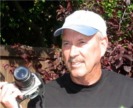The Birth of Hot Rodding: The Story of The Dry Lakes Era by Robert Genat and Don Cox
Submitted by Admin on

Book review by Richard Parks, photographic consultant Roger Rohrdanz


Robert Genat and Don Cox have teamed up to bring car buffs a unique book. Genat brings his skills as a writer, and Don Cox provides photographs unparalleled in quality. Genat interviewed many racers who competed at the Dry Lakes in Southern California and captured the spirit that prevailed among this pre and post World War II generation. Cox photographed the energy and the spell, which this racing held over the young men and women of that era. Using the new state of the art 35mm Kodachrome slide film, Cox took some of the first color photos of this early period. There are 96 color plates, many full page, 58 black and white photos, and the book is 156 pages in length. The book is divided into five easy-to-read chapters, with a foreword by Wally Parks, and a short index and bibliography. Take extra care to preserve the book jacket, for it is one of the best that I have seen. The bibliography rests heavily upon rare source material, out of date publications, SCTA archives and books. The foreword and introduction were quite moving and set the stage for the rest of the book.
The first Chapter deals with the Dry Lakes history and I was surprised at the new information presented here which was new to me. I couldn’t believe how clear and stunning the Kodachrome colors were. It is usual to see only black and white photos from this period, and yet here, at the beginnings of this sport, were all these magnificent full-page color prints. Genat doesn’t skip over the early history. In a clear and precise style, devoid of hyperbole, he tells the compelling story of the Dry Lakes racer. Chapter two explains how difficult it was to get to the Dry Lakes, the structure of the organizations that set up the races, and the actual racing and time trials that went on at these meets. Chapter three describes the hot rod clubs and speed shops where we would have found the hot rodders during the time when they weren’t racing. The speed shops and clubs provided a place for the serious racer to pick up tips and learn new ways to enhance the performance of their cars. The clubs provided structure and created a sense of identity.
Chapter four describes some of the roadsters that raced. The author explains the passion, which prevailed at that time for the sporty looking roadster, and the fervent belief that it was the fastest style of racecar. SCTA banned coupes from racing at its meets. To race anything but a roadster was sacrilegious. Other timing associations would organize to allow coupes to run at the Dry Lakes, but the sleek looking roadsters were the pride and joy of the SCTA. Chapter five ends this book with the story of how Dry Lakes racing finally matured into a multifaceted sport that grew to accept the coupes, modifieds, Belly Tanks and streamliners as part of the racing scene. As Genat weaves the story and Don Cox provides the images, this book is equal to, or better than, any book on Dry Lakes racing that I have seen before. There is real substance and historical merit to this book. If you only have a few minutes, then just enjoy the wonderful photos. If you have time, then this book is one of those treasures that you will find impossible to put down. There are quite a few books, many that are out of print, that deal with the Dry Lakes period of hot rodding, but this is the book that you should build your library around.
From the Book

Pictures like this throughout the book are examples of the fact that there were no rules in hot rodding in the 1940’s.

As with many pictures in the book, the background scene shows the car culture and style of the time.
Pick One Up Today!!! www.motorbooks.com or 1-800-826-6600
